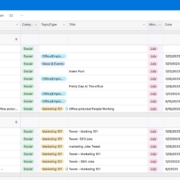Learning the Basics of Social Media Marketing
Maybe you have a new product, but you’re not sure how to advertise it. Perhaps you have a great group of regular customers but can’t seem to find new business. In today’s age of technology, it makes sense for business owners to dive into social media channels, right? While SEO (search engine optimization) is one of the best ways to drive traffic to your website, social media management can increase brand awareness and give potential customers another way to find your business.
It seems like a lot, but don’t worry. We’ll break down the different parts of social media marketing, including social media presence and how to build relationships with potential customers in the process. Ready? Let’s go.
Breaking Down the Most Popular Social Media Platforms
Each major social network has its own unique audience and user base. Let’s look at the amount of social media users and their demographics for some of the popular social media platforms.
A social media platform is made up of a network of people who make social media accounts and display social media profiles. Some platforms are photography-based like Instagram, while others are microblogging like Twitter.
Nowadays, small businesses, big-box stores and everyone in between are using social media to market their eCommerce through social media advertising. At the same time, social media is a great platform to show potential customers that you’re an expert in your field and a trusted source when they’re ready to buy.
Let’s look at some of the most popular social media sites to understand the user base and format of each.
-
- Facebook – Nearly 3 billion people, largely between 25 and 35 years old. This is the most used social media network around the globe. Users can upload pictures, videos, ads and text.
- YouTube – About 2.2 billion users. People between 15 and 35 are the largest demographic of users. Videos are uploaded and watched.
- Instagram – 1.5 billion people use Instagram. Globally, users are younger than 35 years old. Photos and videos are shared with followers or a chosen group of friends.
- TikTok – There are more than 1 billion users worldwide, with nearly 45% of users between ages 18 and 24. Short videos (often less than a minute) are uploaded and viewed.
- LinkedIn – More than 820 million people use this business-based platform. Around 60% of account holders are between 25 and 34 years old. Used to find internships or job opportunities, LinkedIn is based on building professional connections.
- Twitter – There are about 450 million users with the main demographic being 25 to 34-year-olds. This is a micro-blogging site where tweets are posted.
- Pinterest – About 431 million people use this platform worldwide. The target demographic is made up of mostly women, specifically ages 50-64. It’s a virtual pinboard.
- Snapchat – There are more than 330 million users around the world, with users largely between 18 and 24 years of age. Videos and pictures are sent to others, but once they are viewed the content “disappears.”
Nail Down a Social Media Marketing Strategy
Once you’ve determined which social media platform is best for your business, it’s time to create a social media marketing strategy to build brand awareness. This is the ability for consumers to immediately recognize a product or service simply by its name.
Think of this strategy as an outline of what you want your brand to look like. What do you want to achieve? Believe it or not, there isn’t a one-size-fits-all approach to which types of content perform on the different social media platforms. Because each user base varies, each audience prefers different types of content. Remember to always keep your target audience in mind when creating content and choosing which social media platforms to post them on.
Content Strategy Backed by Research
Whether launching a new product or service, your content strategy will impact how you grow.
To effectively reach your target audience, you must do some marketing efforts. Some of the best social media practices include researching.
Look into your target audience. Identifying who you are trying to reach will lead you to the social platforms to carry out our social media marketing plan. Once you have a handle on where your target audience spends their time, you can begin to organize which types of content to curate into your socials. It’s important to establish rules surrounding the type of content you’ll post, too, to keep a bit of uniformity in your social strategy.
It is also worth looking into different paid advertising options. Say you’re going to focus on increasing your brand awareness on Facebook. Look into Facebook ads, which are a popular way to tailor ads on the platform.
While researching who your target audience is and what sites they frequent, don’t forget about competitive analysis. Look at your competitors and the marketing efforts they’re employing.
Building a Content Calendar
What’s the first thing you think of when brainstorming how to grow your business or brand? It’s likely how to bring it to people. The first step in a social media marketing strategy is planning out content creation — or which kinds of social media posts you want to be included in your social media marketing campaign.
Keep posts organized by planning out a content calendar. This helps keep content reaching your audience regularly. Using a content calendar maps out what is posted and when, so there aren’t random ideas or repeated content posted. Content calendar templates are available by searching online, or by using content management software like Hootsuite and Hubspot.
Repost content relevant to your brand. Figure this into your content calendar to switch up your original content. As your content grows, find new ways to share your content by repurposing blogs and pictures, and choosing a different angle to focus on.
What’s The Deal With Influencers?
Consider using an influencer to reach a broader audience. Influencers are people who recommend a product or service on social media. They can be a celebrity or bloggers and content creators with a social following.
Here’s a fun fact: Millennials – people born between 1981 and 1996 – are largely influenced by listening to their peers. Sometimes this is even through content marketing, which is sharing social media content that doesn’t directly promote a brand but rather generates interest.
Hire an influencer with your product or service or pay a well-known blogger for a sponsored post. A fun way to integrate your work with an influencer is having them “take over” your socials for a day or week. Find an influencer with an audience similar to yours and see your following list take off.
Are You Making Gains?
There are ways to see if your hard work at curating the best social media marketing is paying off. An easy way to start this conversation is by utilizing hashtags.
A hashtag is a metadata tag that follows the hash sign (for older Millennials and Gen X-ers, it’s also known as the pound sign). Hashtags can be used on any social media, and are especially popular on Instagram or Twitter. These tags can be used as a social listening tool. Use them to search your own company name to see what people are saying about your brand. There are also social listening platforms that help see what people are saying about your brand in real-time like Sprout Social.
Social listening is one of the most important tactics to understand how your brand awareness (and brand likeness) is working, but you should also be tracking hard metrics across all social media campaigns. Some important data sets to track are followers, engagement rates, likes, reposts, impressions and video views, depending on the social media site.
It’s Time to Start Your Digital Marketing Journey
Now that you know what social media marketing is and some of the many moving parts, it’s time to try it out to meet your business goals. Producing social media posts and content that people actually want to see and providing high-quality products and services can be a lot. Don’t fret; that’s why we’re here. Contact us today so we can start to create a specialized social media strategy for your brand.










